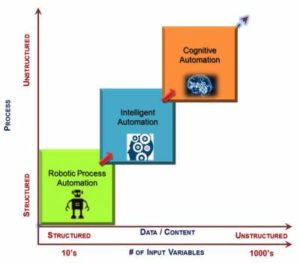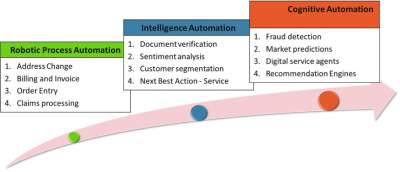OBJECTIVE
RPA + Machine Learning(ML) + Artificial Intelligence(AI) + Python + Adv. RPA
WHAT YOU WILL BUILD
1. End to End Automation of Enterprise projects using RPA Blueprism .
2. Face Detection and Recognition using Pyhton and Machine Learning .
3. Build Credit Card Fraud Detection System using Machine Learning and AI .
4. Complete Guide to Python for Cognitive RPA with real time projects .
5. Introduction to Google TensorFlow and Python libraries for ML and AI .
6. Integrating RPA with AI and ML for intelligent Automation and BOT Monitoring .
7. IBM Watson, NLP Engine and how it fits into the RPA domain with scenario.
8. Build Intelligent automation by integrating RPA with IBM Whatson
RPA vs Machine Learning vs Artificial Intelligence
RPA is a software that enables automation of human intensive data centric activities by leveraging the user interface of existing applications. “Bot” is the term used to refer the software that automates the tasks. We can run the Bots either on operator desktops or remotely.
Machine Learning is a programmatic approach to building algorithmic models using statistical principles, to solve data centric tasks such as classification, grouping, prediction and association. When we use Machine learning to automate the tasks, we refer to it as “Intelligent Automation”.
AI deals with sophisticated learning and prediction systems, trained to automate the desired tasks. The major evolution in AI as compared to Machine learning is the use of concepts like neural networks to build models inductively. Essentially, we are creating a learning engine that learns from vast number of inputs and outputs to start predicting the outcomes. Over a period of training, the AI engine starts to provide outcomes even when we have not provided all inputs or the training data set does not have a matching input-output combination. “Cognitive Automation” refers to automation of tasks leveraging the AI capabilities.
Cognitive RPA Use cases
The capabilities offered by RPA, Intelligent Automation (Machine Learning) and Cognitive Automation (AI) address different categories of problems based on the value proposition offered by each. I have shared a few sample use cases across the automation spectrum in the below diagram.
In the first box from the left, we have the use cases for RPA. RPA addresses Digital labor arbitrage as a core value proposition. Most use cases for RPA would involve human operators, structured data inputs and outputs. Hence, we can automate processes that are repetitive in nature as listed in the first box below. We should be able to model these activities graphically due to the repetitive and deterministic nature of inputs and outputs.
The value proposition of intelligent automation is not about replacing humans but “enabling” or “assisting” humans in processes, which would involve semi-structured content, collaborative processes and real time decisioning for operators. The second box lists such use cases under the title “Intelligent automation”. We would be using Machine-learning algorithms to assist human functions with prediction, classification, associative or grouping capabilities.
The last box with the title “Cognitive automation” involves use cases, which are beyond human capabilities. These use cases have a common pattern of involving multi-dimensional data sets that may span across time horizon, geographies, devices/ channels and entities.
Cognitive Automation is the Future
To extend the field of application of RPA tools, leading vendors are investing in cognitive technologies such as machine learning, speech recognition, and natural language processing.For example, RPA developer Automation Anywhere has developed computer vision technologies and machine learning capabilities in-house. In loan processing, the company has used natural language processing techniques to extract sentiment from supporting documentation in order to establish loan applicants’ creditworthiness. UiPath says it is working with cognitive technology tools from third parties, including open-source machine learning libraries, to craft point solutions for clients. Blue Prism’s cognitive strategy centers on partnering with cognitive technology specialists. The company has announced a partnership with IBM Watson, with the goal of integrating cognitive technologies into process flows.
While many large enterprise software vendors have begun to incorporate cognitive technologies into their products, and applications of machine learning that provide greater insight to organizations are proliferating, we believe that enterprises have been relatively slow to implement cognitive process automation applications. This is because architecting and building custom solutions based on cognitive technologies can be complex, and the required skills scarce. The growing RPA market is likely to increase the pace at which cognitive automation takes hold, as enterprises expand their robotics activity from RPA to complementary cognitive technologies.
Deploying cognitive tools via bots can be faster, easier, and cheaper than building dedicated platforms. By “plugging” cognitive tools into RPA, enterprises can leverage cognitive technologies without IT infrastructure investments or large-scale process re-engineering. Therefore, businesses that have deployed RPA may be more likely to find valuable applications for cognitive technologies than those that have not.
Who should learn Cognitive Automation
- Are you developers and interested in cognitive automation?
- Are you a tester (manual/automation) and willing to transform your career?
- Are you a BPO/Support professional and willing to switch your career to cognitive automation?
- Are you an operation professional and willing to learn cognitive automation?
- Are you a manager and willing do your hand dirty by learning Cognitive Automation?
Why you should learn Cognitive RPA ?
Becoming a Cognitive Automation professional puts you on the path to an exciting, evolving career that is predicted to grow into 2020 and beyond. Robotic RPA, Artificial intelligence and Machine Learning will impact all segments of daily life by the year of 2025, with applications in a wide range of industries such as Banking, Financial services and Insurance (BFSI), Telecom, IT Industry,Travel, Hospitality, Retail ,Consumer Goods, Manufacturing ,Logistics/Supply Chain Industry ,Healthcare, Pharmaceutical, Business Process Outsourcing (BPO) industry. The need for Automation specialists exists in just about every field as companies seek to give computers the ability to think, learn and adapt.
What skills you will learn from Cognitive RPA ?
By the end of this Cognitive & RPA Automation, you will be able to accomplish the following:
- Understand Robotic Process Automation (RPA) and its value proposition
- RPA industry use cases across Banking, Insurance, Healthcare, IT and SCM etc…
- Learn Blue Prism and how to to use different component to automate process
- Learn Blue Prism Installation, Process and Object Studio, Control room, Queues, Login agent and Surface automation
- Learn IBM Whatson NLP engine
- Learn IBM Chatbot and design virtual assistance
- Learn and Design Face reorganization using Image Analytics
- Learn and Design Speech to text and Text to Speech
- Learn and build intelligent automation by integrating RPA with IBM Whatson
- Learn RPA (Blue Prism) and Whatson deployment scenario
- Interview scenario and increase the chance of employability
Cognitive Automation Example
Every person we speak to might have a different answer depending on his or her experience and background. Let us consider the two dimensions that primarily dictate the automation space: viz. Data and Process. 
In the above diagram, The X-axis and Y-axis represent the Data and Process dimensions respectively. The process axis varies from structured to unstructured scale. The Data axis varies on the structure and volume of input variables. The above graph represents a spectrum for automation, which begins with RPA and moves up into intelligent automation and then cognitive automation. The below table describes each of these domains.

